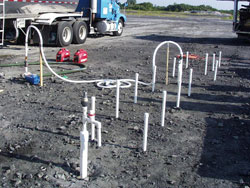| |
Introduction
|
In Situ Chemical Reduction
In situ chemical reduction research efforts have led to the development of an innovative technology for remediating dissolved-phase chromium in groundwater. ORD researchers have received a U.S. patent for this innovative remedial technology.
|
|
In situ chemical reduction refers to the use of chemical amendments to promote reducing conditions in aquifer formations in order to transform or remove contaminants from groundwater. The chemical amendments are generally introduced as injected liquid solutions or by emplacement of a solid media in the path of a contaminant plume. Our work has included the use of a ferrous iron + sodium dithionite reductant solution blend to form in situ reactive zones capable of passively treating groundwater contaminants, such as Cr(VI) moving through the reactive zone under natural gradient conditions. Other projects have included use of combined zero-valent iron + organic matter solid media in the form of a permeable reactive barrier to promote sulfate-reducing conditions in groundwater and subsequent removal of metals and arsenic as secondary sulfide mineral phases.
References and Products
Ludwig, R.D., D.J.A. Smyth, D.W. Blowes, L.E. Spink, R.T. Wilkin, D.G. Jewett, and C.J. Weisener. (2009). “Treatment of Arsenic, Heavy Metals, and Acidity Using a Mixed ZVICompost PRB.” Environ. Sci. Technol., 43, 6: 1979–1976.
Ludwig, R.D., C. Su, T.R. Lee, R.T. Wilkin, and B.M. Sass. (2008). “In Situ Source Treatment of Cr(VI) Using a Fe(II)-Based Reductant Blend: Long-Term Monitoring and Evaluation.” J. Environ. Eng., 134, 8: 651–658.
Ludwig R., C. Su, T.R. Lee, R.T. Wilkin, S.D. Acree, R.R. Ross, and A. Keeley. (2007). “In Situ Chemical Reduction of Cr(VI) in Ground Water Using a Combination of Ferrous Sulfate and Sodium Dithionite.” Environ. Sci. Technol., 41: 5299–5305.
Su, C. and R.D. Ludwig. (2005). “Treatment of Hexavalent Chromium in Chromite Ore Processing Solid Waste Using a Mixed Reductant Solution of Ferrous Sulfate and Sodium Dithionite.” Environ. Sci. Technol., 39: 6208–6216.
Chapelle, F., J. Wilson, and R. Ludwig. “Redox Processes for Remediation of Chlorinated Hydrocarbons and Methyl tert-Butyl Ether.” In: Workshop on Monitoring Oxidation- Reduction Processes for Ground Water Restoration – Workshop Summary, Dallas, Texas, April 25–27, 2000 (PDF) (148 pp, 1.49 MB) (EPA/600/R-02/002) January 2002
Ludwig, R.D., M. Barcelona, and K. Piontek. (2002). “Redox Processes in Petroleum Hydrocarbon Site Characterization and Remediation.” In: Workshop on Monitoring Oxidation-Reduction Processes for Ground Water Restoration – Workshop Summary, Dallas, Texas, April 25–27, 2000 (PDF) (148 pp, 1.49 MB) (EPA/600/R-02/002) January 2002
Ludwig, R.D., R.G. McGregor, D.W. Blowes, S.G. Benner, and K. Mountjoy. (2002). “A Permeable Reactive Barrier for Treatment of Heavy Metals.” Ground Water, 40, 1: 59–66.
McGregor, R.M., S. Benner, R. Ludwig, D. Blowes, and C. Ptacek. (2002). “Sulfate Reduction Permeable Reactive Barriers to Treat Acidity, Cadmium, Copper, Nickel, and Zinc: Two Case Studies.” In Handbook of Groundwater Remediation Using Permeable Reactive Barriers. Edited by D. Naftz, S. Morrison, C. Fuller, and J. Davis. Elsevier.
Contact
Ralph Ludwig
Environmental Scientist
580-436-8603
Chunming Su
Soil Scientist
580-436-8638
You will need Adobe Reader to view some of the files on this page.
See EPA's PDF page to learn more. |
![[logo] US EPA](../gif/logo_epaseal.gif)
